| Click above to watch the content of this web site in video form. After watching the eighty-six minutes in the playlist (which consists of six segments), you will have seen all of the material on this site, except for a small number of items identified in the text portion of the web site as “Web Bonus Content and the contents of the Appendices page.” [Following playback of the six-part series, the playlist will continue with a seventh video (running under two minutes) which is not part of the series but supplements one aspect of it.] Those who prefer to read rather than listen to the narration in the video, can get the same facts by remaining on this page and continuing with the succeeding pages. Visitors who experience the content in this way won’t miss the film clips interspersed within the full video, because the film clips have been isolated for one-subject playback and have been placed between the same text passages as where the clips appear in the full video. Most citations for newspaper clippings, and all identifying information for the film clips, are omitted in the videos. Viewers of the full video who want to know the source of a particular item, should come to the text pages to obtain the desired citations. |
Actors Chosen for Ayn Rand Roles
This web site is divided into four main pages plus a page of appendices.
Use this navigation pane to go directly to a particular page.
1. • Ayn Rand’s Early Hollywood Years
• “Night of January 16th” under its original Broadway producer . . . . go there
2. • “Night of January 16th” as a movie
• We the Living adapted for Broadway . . . . go there
3. • Ayn Rand returns triumphantly to Hollywood . . . . go there
4. • Other “Night of January 16th” productions
• Juries and Jurors
• Cast ideas for Rand’s Magnum Opus . . . . current page
Appendices. Contents include: the proper title for “Night of January 16th,”
Ayn Rand’s cast choices for Atlas Shrugged,
and further information about the actors discussed in the main pages . . . . go there
Other “Night of January 16th” productions |
||||||
Productions of “Night of January 16th” have been ongoing since the Broadway premiere—regionally, locally, at high schools and colleges—providing early opportunities for actors who would go on to national attention. image: Washington Post, February 28, 1937, pg. T2 |
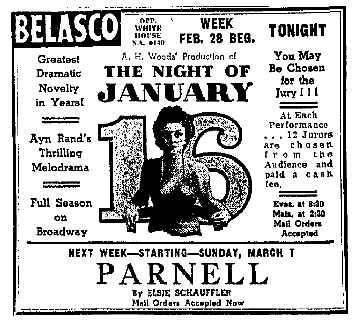 |
|||||
| ||| | ||| | |||||
Morgan Conway played lead roles in detective movies of the 1940s. A 1939 profile indicates he rose from a role in a Hollywood revival of “Night of January 16th.” The story has the title wrong. image: Los Angeles Times, August 24, 1939, pg. A4; red line indicates separation of two sections of the story |
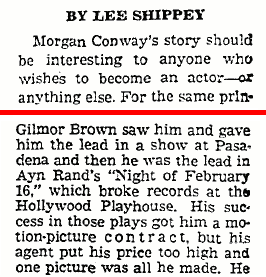 |
|||||
Here’s Morgan Conway in 1945. film source: Morgan Conway in Dick Tracy (1945), with Joseph Crehan
|
||||||
| ||| | ||| | |||||
| A local production outside Boston in 1937 which drew as its female lead a sometimes movie actress and which boasted a member of the Broadway cast, also had among its South Shore Players— images: two sections of a story in the Boston Globe, July 20, 1937, pg. 17 |
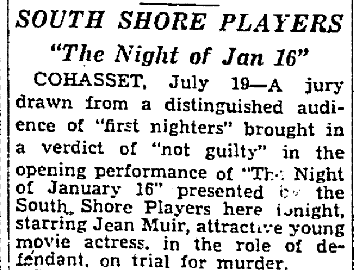 |
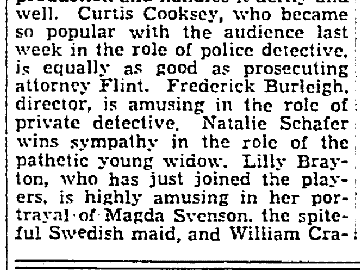 |
||||
—actress Natalie Schafer, who for a decade had worked intermittently on Broadway but had yet to perform in a Hollywood film. The Massachusetts reviewer found that she won “sympathy in the role of the pathetic young widow.” [The following remarks are spoken as narration during the video:] The goofy performance we see her give here (on film eleven years later) is far from a performance evoking sympathy or sadness— —yet it is this goofy personality that she showed in her best-known role, that of the millionaire’s wife on the Gilligan’s Island television series. film source: Natalie Schafer in The Time of Your Life (1948), with Howard Freeman (Schafer’s companion), William Bendix (waiter), James Cagney (sitting at center table), Wayne Morris (Cagney’s assistant) |
||||||
|
||||||
| ||| | ||| | |||||
| Gloria Stuart has become remembered as the old lady in the James Cameron version of Titanic whose story is told in flashback. During the early and mid 1930s she was a busy leading lady in films, including many horror classics. In between, however, she headlined “Night of January 16” in Ridgefield, Connecticut, in 1940 starting July 8. | 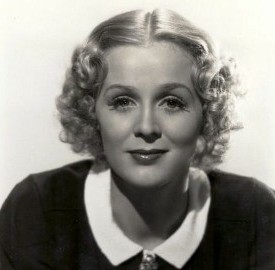 |
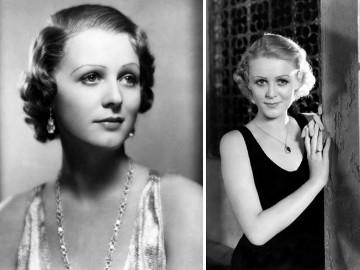 |
||||
| ||| | ||| | |||||
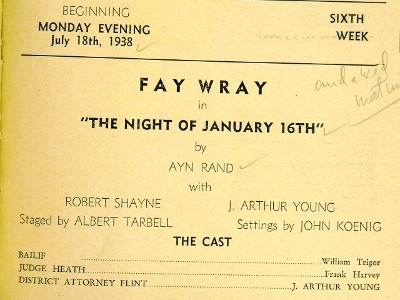 |
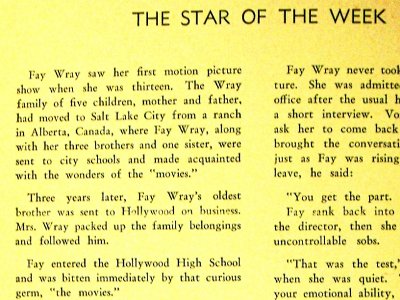 |
|||||
| Fay Wray was also a busy lead actress in early 1930s Hollywood films who thereafter has been most remembered for some classic horror films: particularly as the young woman in King Kong’s hand in the original King Kong— images: program for engagment of FayWray in Great Neck, Long Island; the two featured co-stars were veterans of the play (discussed elsewhere at this web site) |
||||||
| —and The Most Dangerous Game, which you are seeing here. In 1938, she was playing Karen Andre in Great Neck, New York, on Long Island. The program devoted more than a page to a biographical sketch of her. film source: Fay Wray in The Most Dangerous Game (1932), with Joel McCrea |
||||||
| ||| | ||| | |||||
| Rose Hobart had followed stardom on Broadway in the late 1920s with lead woman roles in some significant Hollywood films, including the 1930 version of Liliom and the Fredric March version of Dr. Jekyll and Mr. Hyde [1932]. (Another well-regarded horror film!) She played Karen Andre in Maine in 1936. film source: Rose Hobart in East of Borneo (1931), with Charles Bickford |
||||||
| ||| | ||| | |||||
| Playing the role of handwriting expert for the police James Chandler in that same Maine production was a 19-year-old man just starting out in professional acting. image: program for engagement of Rose Hobart in Maine |
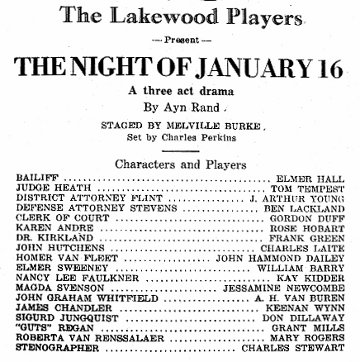 |
|||||
[The following remarks are spoken as narration during the video:] A few years later he would have the first role in many of a 44-years-long career of small and supporting roles in Hollywood movies. His name: Keenan Wynn. film source: Keenan Wynn in My Dear Secretary (1948), with Laraine Day |
||||||
| ||| | ||| | |||||
| Kitty Carlisle had starred in musical films, in Broadway shows, and on radio. She’s remembered for being the leading lady opposite the Marx Brothers in their 1935 classic A Night at the Opera. images: (right) Kitty Carlisle; Kitty Carlisle with Walter Woolf King in A Night at the Opera; poster for A Night at the Opera with art work by Al Hirschfeld and a picture of Carlisle bottom right |
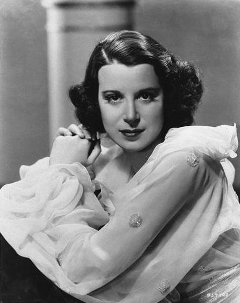 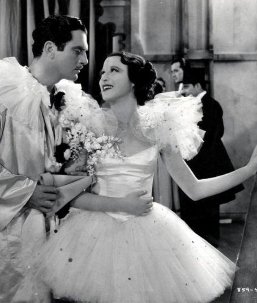 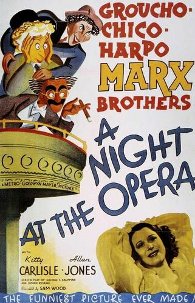 |
|||||
| Her decades as panelist on such television game shows as To Tell the Truth were still ahead. In 1938, Kitty Carlisle played Karen Andre in Locust Valley on Long Island. In her personal life, she was married to playwright Moss Hart, and the couple were best friends and constant companions with Bennett and Phyllis Cerf. Bennett Cerf was editor and publisher at Random House when the firm published Atlas Shrugged in 1957, and Cerf had constant dealings with Ayn Rand when Rand was a top author for the firm. [Probably lost to history is whether Bennett Cerf brought up in conversation with the Harts that Cerf had signed Ayn Rand, and whether Kitty Carlisle responded by saying that she had starred in Rand’s play two decades earlier.] image: (right) career sketch of Carlisle in theater program for engagement with Kitty Carlisle in Locust Valley, Long Island |
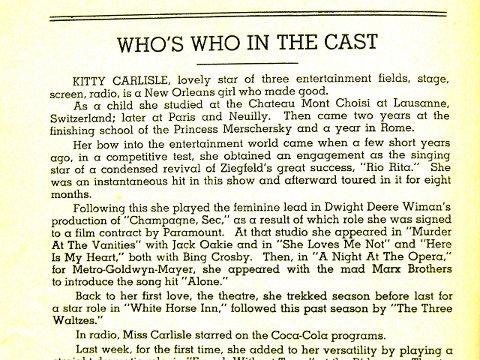 |
|||||
| ||| | ||| | |||||
| Arthur Space was a busy actor in Hollywood during the 1940s and 1950s, bringing his dignified manner to roles as bankers, sheriffs, coroners, medical doctors, inventors, often in Westerns. He got early experience in such roles in 1936 by playing the medical examiner in productions of “Night of January 16” in Chicago and Pittsburgh. image: cast list with Arthur Space listed in program for engagement of “Night of January 16” in Pittsburgh, November 1936; Sarah Padden was repeating her role from the Broadway run. Note: The program for the Pittsburgh engagement indicates that it was presented by A. H. Woods, Ltd. The engagement is being brought up with the revivals inasmuch as the only aspect under discussion here are cast members brought in late in Woods’s connection to the play. |
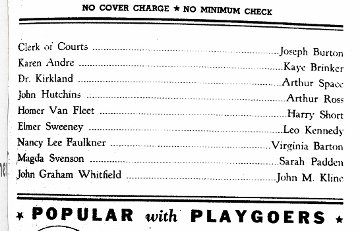 |
|||||
film source: Arthur Space in Home in Oklahoma (1946), with Roy Rogers and Dale Evans |
||||||
| ||| | ||| | |||||
| In those same 1936 Chicago and Pittsburgh productions, Richard Carlson played the bookkeeper and secretary to Bjorn Faulkner. He began two years on Broadway the following year, and in 1938 entered movies. image: cast list with Richard Carlson listed in program for engagement of “Night of January 16” in Chicago; also named are Arthur Space (see immediately above), Sarah Padden, J. Arthur Young, and another veteran of the Broadway run and prior revivals, Marcella Swanson |
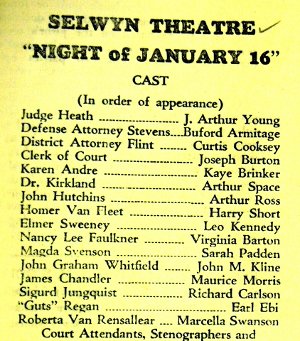 |
|||||
| In Hollywood films of the 1940s Richard Carlson played many young men with an academic demeanor, and he continued in movies and television through 1975. film source: Richard Carlson in Beyond Tomorrow (1940) Carlson may be best remembered for starring in the 1954 movie in 3D The Creature from the Black Lagoon. |
||||||
| ||| | ||| | |||||
| Carlson that same year also played the bookkeeper-secretary in Dennis, Massachusetts, where a fellow cast member would go on to achieve even greater fame. image: program for engagement with Lee J. Cobb and Richard Carlson in Dennis, Massachusetts; others in the cast include these veterans of the Broadway production: J. Arthur Young (now in a larger role), Arthur Pierson, and Ruth Matteson (Doris Nolan’s replacement on Broadway)
|
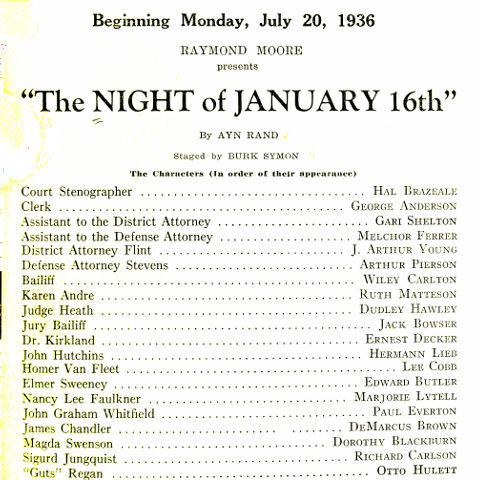 |
|||||
| Lee J. Cobb would star in the original Broadway production of “Death of a Salesman” and in the 1957 movie of Twelve Angry Men played the bigot juror—the angriest of the twelve. His talent was recognized by Broadway casting directors way back in 1935 and 1936, so he often went from show to show. Early in a six-month break in Broadway work, he played the private investigator who shadowed Bjorn Faulkner in the aforementioned 1936 Massachusetts production of “Night of January 16th.” image: The New York Times, March 3, 1949, pg. 32 |
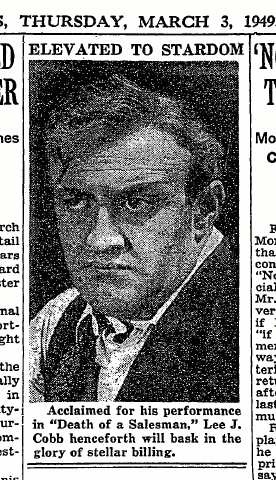 |
|||||
| Cobb entered the movies in 1937, alternating stage and screen thereafter; you’re seeing him in one of those 1937 movies. film source: Lee J. Cobb in Rustler’s Valley (1937) |
||||||
| ||| | ||| | |||||
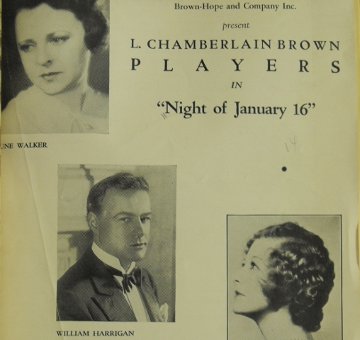 |
William Harrigan was a stage veteran when he played Guts Regan in Bronxville in summer 1936. He had made his Broadway debut thirty years earlier and following this production would work on Broadway again over the next twenty-one years. He knew someone he could consult on the role of “Guts” Regan: Harrigan’s sister Nedda had played Karen Andre in San Francisco and Hollywood earlier that year. | 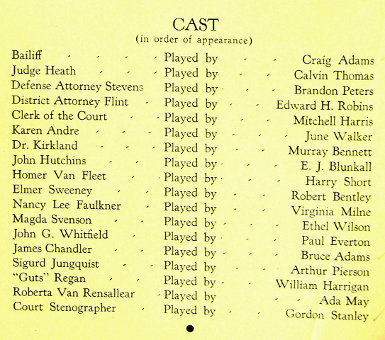 |
images: from the program for the play in Bronxville, New York, with William Harrigan in a lead; cast member Arthur Pierson was from the Broadway cast |
||
| ||| | ||| | |||||
film source: William Harrigan in Hawaii Calls (1938), and Exiled to Shanghai (1937), with Wallace Ford |
||||||
| ||| | ||| | |||||
| Also playing “Guts” Regan during the summer of 1936 was the actor who had spent more time with the playwright than any other actor. As the program for this Stony Creek, Conn., production makes clear, Frank O’Connor was the husband of playwright Ayn Rand. The biographical sketch was otherwise fanciful, as O’Connor had not been in movies as a child, and his appearance in Orphans of the Storm was too inconsequential for him to be remembered for it. images: career sketch of Frank O’Connor in the program of the play in Stony Creek, Connecticut; Robert Shayne is to be discussed here next
|
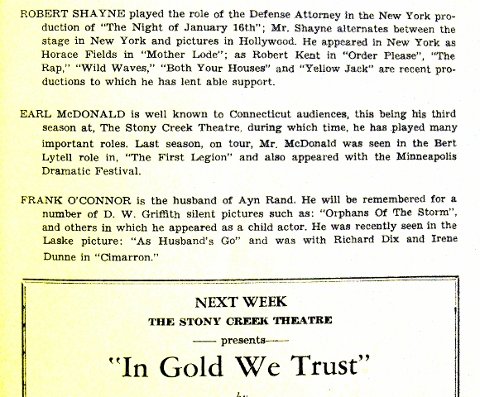 |
|||||
| You may have noticed an actor already discussed—Robert Shayne—atop the cast. Shayne took his experience in the Broadway production, and parlayed it into hires in many more cities, large and small. The next actor discussed here did likewise. image: the cover of the Stony Creek program Note: Shayne also played Defense Attorney Stevens in Cohasset, Massachusetts, summer 1937, and in Great Neck, Long Island, summer 1938. Though Robert Shayne played a lawyer in productions of Night of January 16th starting with the 1935 Broadway production, he would have transitioned to the major gangster role had Ayn Rand prevailed in a suggestion to the company behind the Broadway production that, rather than William Bakewell being hired as Walter Pidgeon’s replacement days prior to Pidgeon’s last performance, the role go to one of two two suggested alternatives she offered: “... Mr. Robert Shayne, who knows the part.” (letter by Ayn Rand dated October 14, 1935, in Letters of Ayn Rand, page 23) |
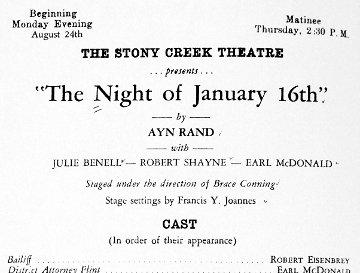 |
|||||
| [This is part of the cast list as it appears in the first
Playbill of the original Broadway production. Among the actors listed are Robert Shayne and J. Arthur Young.] image: the first program of “Night of January 16” on Broadway and the first under that or similar title |
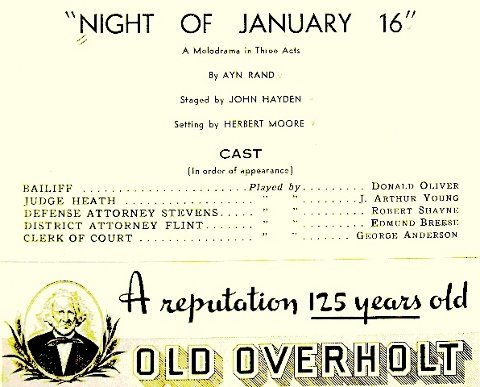 |
|||||
| J. Arthur Young had little to say in the original Broadway production of “Night of January 16.” As the judge, he had about three dozen lines, all short, many just a single word. Nonetheless, those months of performances exposed him so thoroughly to the larger roles that he was a wise choice for producers in other cities in casting an attorney. image: a dialogue exchange in “Night of January 16th” with highlighting of some of the judge’s short lines; reproduced from a much-later mass-market paperback edition of the play |
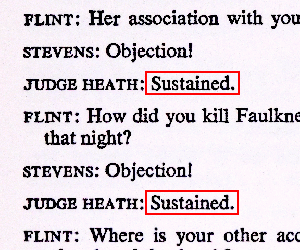 |
|||||
[The following remarks are spoken as narration during the video:] In this 1941 film, he demonstrates skill at testifying. The lady is Sarah Padden, the maid in the Broadway production. With Sarah Padden and J. Arthur Young both veterans of the Broadway production, this movie was a reunion. film source: J. Arthur Young in Murder by Invitation (1941), with Sarah Padden Notes: J. Arthur Young played Judge Heath on Broadway, September 1935, and in Boston, April 1936. He played District Attorney Flint, in Dennis, Massachusetts, July 1936, then returned to playing Judge Heath in Chicago, November 1936, and in Pittsburgh, also November 1936. Afterward, he again played District Attorney Flint: in Omaha, April 1937; Great Neck, Long Island, summer 1938; and Locust Valley, Long Island, summer 1938. |
||||||
| ||| | ||| | |||||
| Alexis Smith was leading lady to the major leading men at Warner Bros. throughout the 1940s, but that followed from her being spotted by a talent scout who saw her in her college’s student production of “Night of January 16th.” image: Boston Globe, September 30, 1979, pgs. D1,8,9 |
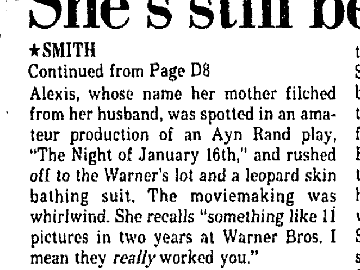 |
|||||
film source: Alexis Smith in a coming attractions trailer for The Horn Blows at Midnight (1945); the scene excerpted here does not appear in the copyrighted feature film |
||||||
| She was in her twenties in all her movies of the 1940s, the decade when she most frequently was co-starred in movies. images: Alexis Smith and Humphrey Bogart in The Two Mrs. Carrolls |
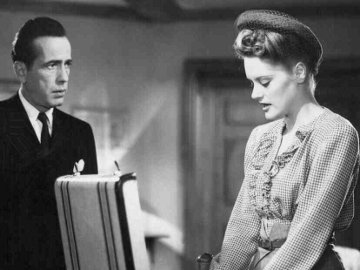 |
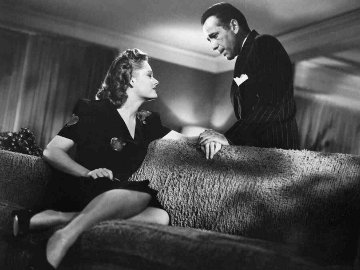 |
||||
| The stars she played opposite included Humphrey Bogart, Cary Grant, Jack Benny and Errol Flynn. | 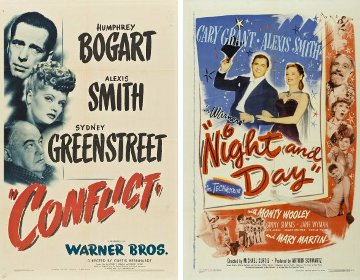 |
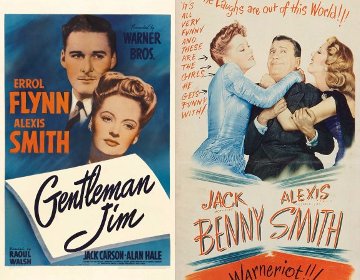 |
||||
| ||| | ||| | |||||
| Charles Bronson was one of the biggest movie stars of the 1970s and 1980s, starring in vigilante and other action movies. This obituary reports that Bronson made his New York stage debut in a late 1940s revival of “Night of January 16th.” We’ll look at him in 1950s television dramas. image: Irish Independent, September 2, 2003, pg. 2 |
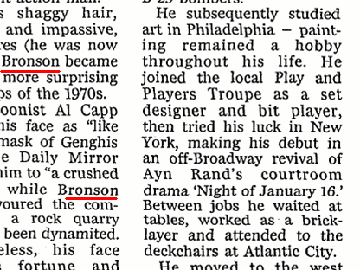 |
|||||
Bronson could play violent, conceited criminals. [The following remark is spoken as narration at the point in the video where the clip of the first production gives way to the clip from the second production:] Next you’ll see [that] Bronson could also play a man of the mind. film source: Charles Bronson in Treasury Men in Action (TV series) episode “The Case of the Shot in the Dark” (1955) with Randy Stuart (as his wife), and Medic (TV series) episode “My Brother Joe” (1954) with Jack Diamond |
||||||
| ||| | ||| | |||||
| Web Bonus Content | |||||
William Dozier executive-produced some class-A feature-length Hollywood movies during the late 1940s, then entered network television production during the 1950s, yet returned to assembling big-name casts for Hollywood movies that same decade. Over his long career, he made friends and contacts working as an executive at Paramount, RKO, Samuel Goldwyn, the CBS network, and Twentieth-Century Fox. A hit television series on ABC from 1966 to 1968 solidified his reputation. In what might otherwise have been his retirement, he took positions on the faculty and regents of Mount St. Mary’s College in Los Angeles. He put on a college production of Night of January 16th (1977) in which he played John Graham Whitfield. Audiences may have recognized his voice as the narrator of his decade-earlier Batman series, where he implored viewers to tune in again, “same bat-time, same bat-channel,” and recapped events from the previous episode in the first minute of shows that continued a story started in the prior broadcast. Source of information about Mount St. Mary’s: Daily Variety, April 28, 1977, pg. 9 |
image: William Dozier credited on the opening titles of the Batman series, 1966-1968. |
||||
| ||| | ||| | ||||
| In 1938, a recent law-school graduate who had returned from Duke University to his childhood town of Whittier, Calif., was offered a role in an amateur production. |  |
||||
The graduate’s having passing his bar exam had opened up to him employment as a lawyer, yet he nonetheless acceded to the local theater-group director’s offer that the young lawyer play a lawyer in the group’s amateur production of Night of January 16th. Though the lawyer’s reputation would not be earned for playing fictional characters, his later career would place him repeatedly on American television screens during prime-time on all broadcast networks. | Often in his television appearances from 1969 to 1974, he was the only person speaking to viewers for a quarter-hour or more at a time. Seventy-eight million votes cast by Americans in the 1968 and 1972 national elections made Richard Nixon the nation’s thirty-seventh President. image: from RN: The Memoirs of Richard Nixon, by Richard Nixon (Grosset & Dunlap, New York, 1978), pg. 23. |
||||
| ||| | ||| | ||||
Juries and Jurors |
|||||
| While we’re talking about celebrities who emerged from acting roles in “Night of January 16th,” it’s worth talking about celebrities who served as jurors on stage in “Night of January 16th.” Ayn Rand in her introduction to the play said that the producer of the Broadway production “was besieged by requests from celebrities and others who wanted to sit on that jury.” film source: Midnight Lady (1932) |
|||||
| ||| | ||| | ||||
| She wrote that there was a performance with Helen Keller as jury foreman where “All the members of the jury and most of the audience were blind. … The verdict that night was ‘Guilty.’” Ayn Rand doesn’t say why this must be, but one might surmise that blind people being as dependent as they are upon others, would not identify with self-sufficient people in choosing from among evidence balanced between two sides. | |||||
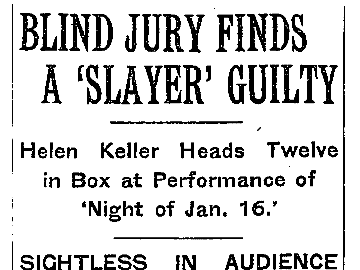 |
A New York Times story about that performance reported that Helen Keller herself voted for the defendant’s acquittal, but was out-voted by the other jurors. Keller said that the evidence was “nicely balanced.” images: two sections of a story in The New York Times, December 16, 1935, pg. 22 |
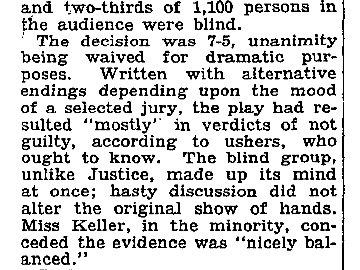 |
|||
| ||| | ||| | ||||
| A story appearing a few days after opening night reported that sitting on the jury was Jack Dempsey, former heavyweight boxing champion of the world. image: Boston Globe, September 20, 1935 Note: The identification in the newspaper caption for Edward J. Reilly being counsel for Bruno Hauptmann, was written for 1935 readers, who would instantly identify Hauptmann as the infamous defendant in the trial of the kidnapping and murder of the baby of Charles Lindbergh, the celebrated pilot who in 1927 was the first to fly solo across the Atlantic. Daily Variety, September 17, 1935, pg. 1, places these jurors on the jury of the opening night performance, by identifying the following as having been among the twelve on September 16: “Col. Fitpatrick of Madison Square Garden; Edward J. O’Reilly, Bruno Hauptman[n]’s chief counsel in Lindbergh kidnaping trial; Jack Dempsey, Dr. Leo Michel and Jimmy Stroock.” |
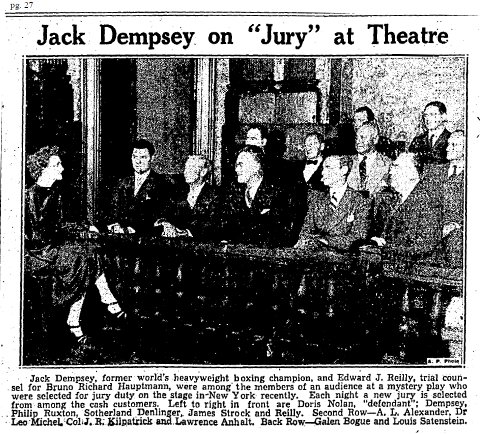 |
||||
| • Three weeks after the opening, one juror was movie star Ricardo Cortez, who during the early 1930s was lead actor in several Warner Bros. dramas. • Playing similar roles at Paramount was George Raft, whose breakout role in Scarface had been three years prior to “Night of January 16” on Broadway. Raft was a juror on Broadway. • A future Hollywood producer who served as Broadway juror was James Roosevelt, whose opportunities were enhanced by his father being America’s president at the time. image (top): Weekly Variety, October 9, 1935, pg. 37 film source: • Ricardo Cortez in Behind Office Doors (1931); image (bottom): James Roosevelt and George Raft are named as jurors in the New York run (still in progress as this was printed), reported in the program for the San Francisco run of 1935-1936
|
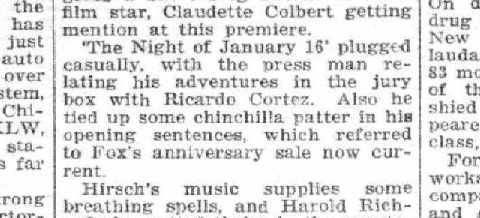 |
||||
| ||| | ||| | ||||
| The 1936 opening day performances in Hollywood at the El Capitan, reuniting the five leads from the San Francisco production recently closed, was, according to the Los Angeles Times and Variety, “overshadowed by notables in the jury box”—including: image: Los Angeles Times, March 4, 1936, pg. A10 Note: the “overshadowed by notables in the jury box” remark appeared in Daily Variety, March 2, 1936, pg 3. |
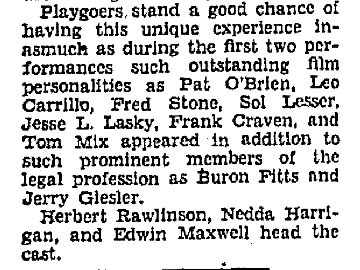 |
||||
| • Leo Carillo, giving energetic performances as supporting player in many movies; • famous Westerns star Tom Mix; you’re seeing him in a lead role in 1935; • Frank Craven, who was yet to become known as the narrator of “Our Town”; • Pat O’Brien, already a star at Warner Bros.; • Fred Stone, who on Broadway had been the original scarecrow in “The Wizard of Oz” [1903] and in 1936 playing a lead movie role at RKO; • Jesse Lasky, one of the founders of Paramount, who, after a long career there, had now recently embarked on a new career as an independent producer; • Sol Lesser, another studio executive who also had success as an independent producer; • Jerry Geisler, well-known Hollywood attorney film source: • Leo Carillo in Fisherman’s Wharf (1939); images: Fred Stone in 1912; |
|||||
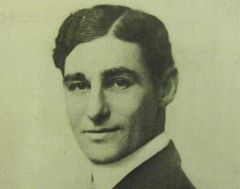 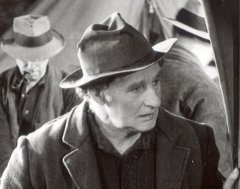 | |||||
|
|||||
| ||| | ||| | ||||
| Celebrities didn’t end with the opening night performance. Within three weeks, additional jurors had included: • Groucho Marx, who took a bow on stage!; • Lila Lee, leading lady in low-budget feature films; • major studio leading lady Dolores Del Rio; • Hoot Gibson, westerns star; • Gail Patrick. She would have a lot more experience with courtroom drama as the executive producer of all nine seasons of the Perry Mason television series in the 1950s and 1960s. film source: • Groucho Marx in You Bet Your Life (TV series, also known as Best of Groucho), introduced by George Fenneman; |
|||||
| ||| | ||| | ||||
| The Los Angeles Times reported that actor Guy Bates Post admitted that throughout the play he unconsciously acted, presumably causing his face and body to take on an outward appearance suitable for the role of juror. images: Los Angeles Times, March 15, 1936, pg. C1; |
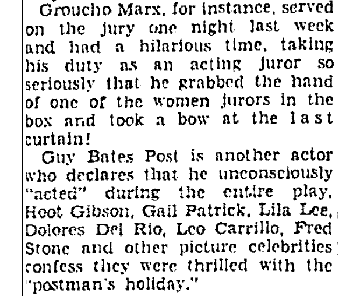 |
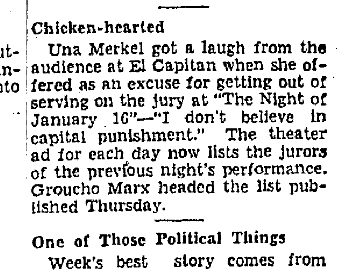 |
|||
| One star who declined jury service was Una Merkel, begging off the assignment by declaring “I don’t believe in capital punishment.” film source: Una Merkel in Abraham Lincoln (1930), with Walter Huston |
|||||
| In late 1936, the London production on opening night had on its jury already-established star actor Raymond Massey. Twelve years later, Raymond Massey would be in America on a Warner Bros. sound stage playing the role of Gail Wynand in The Fountainhead. image: The New York Times, September 30, 1936, pg. 29 |
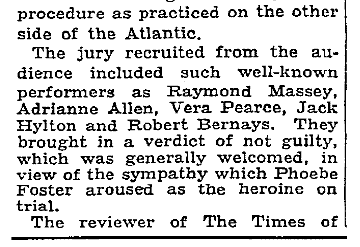 |
||||
| ||| | ||| | ||||
Cast ideas for Rand’s Magnum Opus |
|||||
| No part of Atlas Shrugged was filmed until after Ayn Rand’s death, and posthumous films are not covered by this video (and web site). Ayn Rand did make casting choices during her years after Atlas Shrugged was published in 1957. (In the video counterpart of this web site, some of those choices appear on screen at this point. Readers of this site will find this list in an appendix, as well as citation information not provided in the video.) | |||||
| An ad for the book on the date of publication has the book’s hero represented by a photo of Frank O’Connor, the novelist’s husband. Frank O’Connor also strongly resembles those illustrations of Howard Roark in the newspaper comic-strip serial which appeared 1945 to 1946. image: The New York Times, October 10, 1957, pg. 30 |
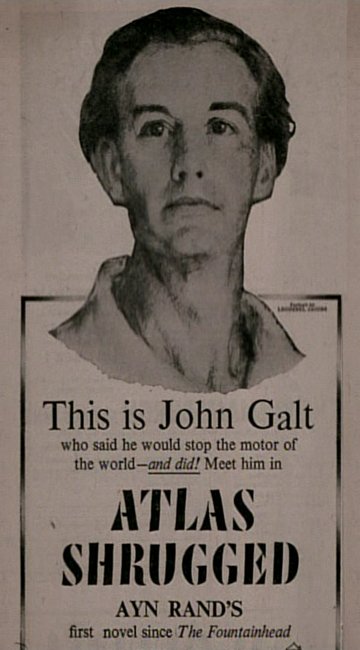 |
||||
| ||| | ||| | ||||
|
| ||| | ||| | ||||
| Late in life, Ayn Rand considered for the role of James Taggart—a villain in Atlas Shrugged—Ned Beatty, who won an Academy Award for playing a megalomaniac corporate head in Network. image: Baltimore Sun, March 1, 1977, pg. B5 |
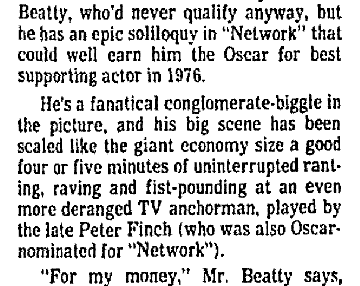 |
||||
| In earlier years, her choice for the role was the more suave Vincent Price. film source: Vincent Price in House on Haunted Hill (1958), with Alan Marshal |
|||||
| There are more roles and many actors were considered for some of them. This survey has provided a sample. (Well, a sampling that looked at most every major role and every known instance of major actors who were considered for Rand characters.) | |||||
| ||| | ||| | ||||
This web site also has a a page of appendices.
New content © 2013, 2016 David P. Hayes
In the video counterpart to this web site, and in the video portions of the site, the Ayn Rand quotations are spoken by Susan Crawford.
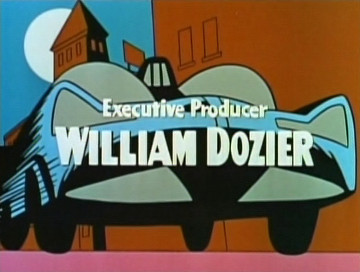

 If you've followed this web site consecutively up to here, you will recognize the actress (in the accompanying small picture) and won't need her name to be stated. If you're keeping a count, this is the fourth time this actress was thought of for an Ayn Rand role that she was destined not to play. In this case, the actress declined the role, foreseeing she would be rejected by studios. She’d recently had her fiftieth birthday.
If you've followed this web site consecutively up to here, you will recognize the actress (in the accompanying small picture) and won't need her name to be stated. If you're keeping a count, this is the fourth time this actress was thought of for an Ayn Rand role that she was destined not to play. In this case, the actress declined the role, foreseeing she would be rejected by studios. She’d recently had her fiftieth birthday.